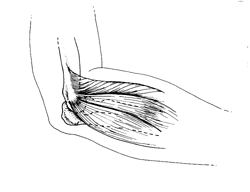|
Lateral Epicondylitis or "Tennis Elbow"
What is it?
Lateral epicondylitis, commonly known as “tennis elbow,” is an inflammation
of the tendon fibers that attach the forearm extensor muscles to the outside
of the elbow. These muscles lift the wrist and hand. Pain may be felt where
these fibers attach to the bone on the outside of the elbow or along the muscles
in the forearm. Pain is usually more noticeable during or after stressful use
of the arm. In severe cases, lifting and grasping even light things may be painful.
Because people who play tennis or other racquet sports sometimes develop this
problem from improper playing technique, it has become known as “tennis elbow.”
Medial epicondylitis or “golfers elbow” is a similar condition that occurs on
the inside of the elbow.
What causes it?
Routine use of the arm or an injury to this area may stress or damage the muscle
attachment and cause tennis elbow symptoms. Generally, people who develop this
problem may be involved in activities with motion of the wrist and arm or lifting
with the palm side of the hand facing down. The condition is quite common in
our late 30s and early 40s.
Signs and symptoms
The area of most pain is usually found near the bone on the outer side of the
elbow known as the lateral epicondyle (see Diagram). This area is usually tender
when touched and may be uncomfortable when gripping. In severe cases, almost
any elbow movement can be uncomfortable.
Treatment
Treatment may include stopping or limiting activities that cause the pain,
such as heavy lifting with the palm facing down. Sometimes a band wrapped around
the forearm near the elbow is used to protect the injured muscles as they are
healing. In some cases, the wearing of a wrist splint may be recommended for
the same purpose. Anti-inflammatory medication, can be taken by mouth. In severe
or long-lasting episodes, an injection of medication into the area may relieve
the discomfort. Your hand surgeon may recommend exercises that stretch and strengthen
the muscles to help prevent the condition from returning. Some patients respond
to additional treatment through therapy. As the condition improves, there is
usually a slow return to normal activities. Recurrence of this condition is
common.
If nonsurgical forms of treatment do not eliminate the pain of this condition,
surgery may be recommended. Your hand surgeon can advise you on the surgical
treatments for lateral epicondylitis and the possible outcomes. Lateral epicondylitis
is often a nagging or chronic condition sometimes requiring many months for
healing to occur.
Tennis elbow is localized to the area where the extensor muscle is attached
to the lateral epicondyle.

Figure 1
Tennis elbow is localized to the area where the extensor muscle is attached
to the lateral epicondyle.
Copyright © American Society for Surgery of the Hand.
All content copied with permission from ASSH (www.assh.org). |